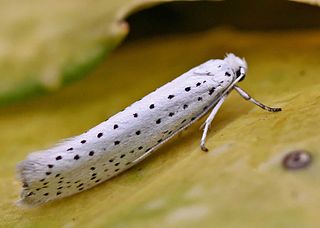
The family Yponomeutidae are known as the ermine moths, with several hundred species, most of them in the tropics. The larvae tend to form communal webs, and some are minor pests in agriculture, forestry, and horticulture. Some of the adults are very attractive. Adult moths are minor pollinators.

The ailanthus webworm is an ermine moth now found commonly in the United States. It was formerly known under the scientific name Atteva punctella. This small, very colorful moth resembles a true bug or beetle when not in flight, but in flight it resembles a wasp.

Attevidae is a family of moths of the Yponomeutoidea superfamily, containing only one genus, Atteva. The group has a pantropical distribution; however, the range of at least one species, Atteva aurea, extends into the temperate zone. No consistent hypotheses regarding the relationships, placement, and ranking of Attevidae have been published, but the prevalent view is that they likely form a monophyletic group within the Yponomeutoidea.

The bird-cherry ermine is a species of moth in the family Yponomeutidae, the ermine moths. The wingspan of the moth ranges from 16 to 25 mm. The insect was first described in 1758 by the Swedish naturalist Carl Linnaeus who gave it the name Phalaena evonymella; it was later transferred to the genus Yponomeuta, becoming Yponomeuta evonymella. The moth can be found in the whole of Europe and the northern and eastern part of Asia.

Yponomeuta plumbella is a moth from the family Yponomeutidae, the ermine moths.

Simarouba glauca is a flowering tree that is native to Florida, South America, and the Caribbean. Common names include paradise-tree, dysentery-bark, bitterwood. The tree is well suited for warm, humid, tropical regions. Its cultivation depends on rainfall distribution, water holding capacity of the soil and sub-soil moisture. It is suited for temperature range of 10 to 40 °C. It can grow at elevations from sea level to 1,000 m (3,300 ft). It grows 40 to 50 ft tall and has a span of 25 to 30 ft. It bears yellow flowers and oval elongated purple colored fleshy fruits.

Argyresthia thuiella, the arborvitae leafminer, thuja mining moth or American thuja shoot moth, is a moth of the family Yponomeutidae. It is found in southeastern Canada and the northeastern United States to North Carolina, west to Missouri, north to Manitoba. There is also an isolated population in British Columbia. The species is also present in Europe, where it has been introduced on three occasions: to the Netherlands in 1971, Germany in 1975 and Austria in 1976.

Atteva pustulella is a moth of the family Attevidae. It is found from Costa Rica, where it meets Atteva aurea, southwards to Uruguay and Argentina. It is also present in the Antilles. There are also several reports from Dominica, Jamaica, Haiti and Martinique.

Atteva hysginiella is a moth of the family Attevidae. It is endemic to the Galapagos Islands.
Atteva gemmata is a moth of the family Attevidae. It was described by Augustus Radcliffe Grote in 1873 and is endemic to Cuba.
Atteva cosmogona is a moth of the family Attevidae. It is found in the Atlantic Forest of Brazil.
Atteva numeratrix is a moth of the family Attevidae. It is found in Brazil.
Atteva rawlinsi is a moth of the Attevidae family. It is endemic to the Dominican Republic.
Atteva sidereoides is a moth of the Attevidae family. It is endemic to the Dominican Republic.
Atteva zebrina is a moth of the Attevidae family. It is found in Brazil.
A. intermedia may refer to:

Simarouba amara is a species of tree in the family Simaroubaceae, found in the rainforests and savannahs of South and Central America and the Caribbean. It was first described by Aubl. in French Guiana in 1775 and is one of six species of Simarouba. The tree is evergreen, but produces a new set of leaves once a year. It requires relatively high levels of light to grow and grows rapidly in these conditions, but lives for a relatively short time. In Panama, it flowers during the dry season in February and March, whereas in Costa Rica, where there is no dry season it flowers later, between March and July. As the species is dioecious, the trees are either male or female and only produce male or female flowers. The small yellow flowers are thought to be pollinated by insects, the resulting fruits are dispersed by animals including monkeys, birds and fruit-eating bats and the seeds are also dispersed by leaf cutter ants.

Simarouba is a genus of trees and shrubs in the family Simaroubaceae, native to the neotropics. It has been grouped in the subtribe Simaroubina along with the Simaba and Quassia genera. They have compound leaves, with between 1 and 12 pairs of alternate pinnate leaflets. Their flowers are unisexual, relatively small and arranged in large panicles. Plants are dioecious, bearing only male or female flowers. The individual flowers have between 4 and 6 sepals and petals and between 8 and 12 stamens. The fruit is a carpophore and has up to 5 drupaceous mericarps.

Atteva fabriciella, the Ailanthus webworm moth, is a moth of the family Attevidae. It is found in China, India and Sri Lanka. It is considered one of deadliest plant pest on Ailanthus species.











